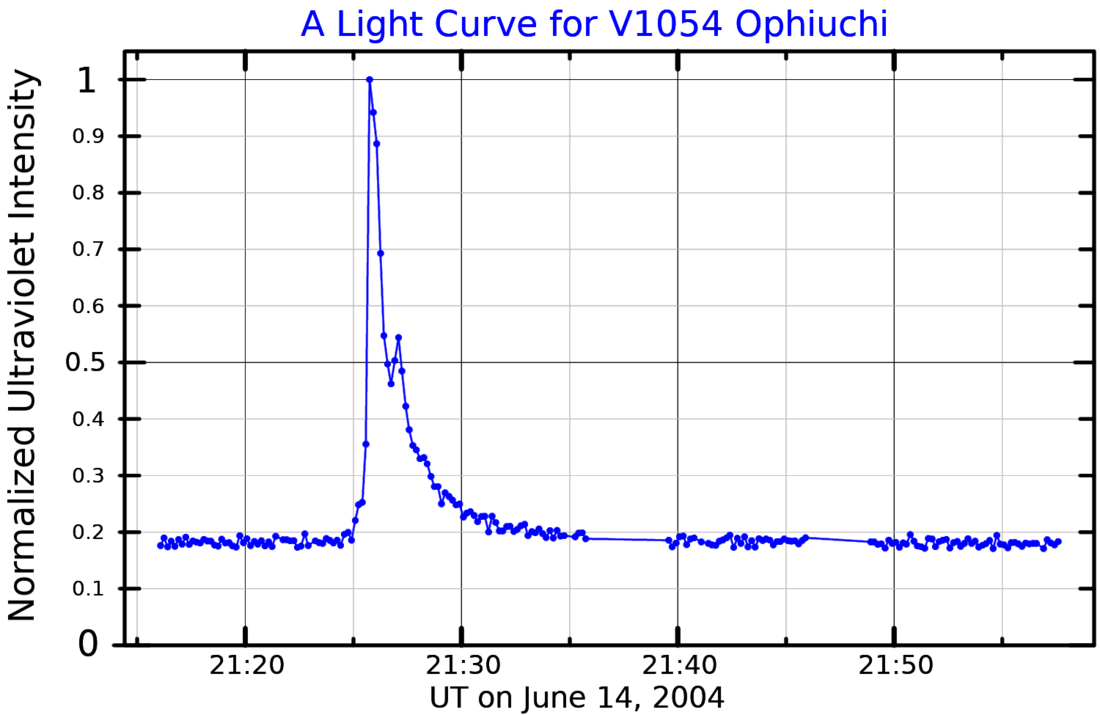Top Qs
Timeline
Chat
Perspective
V1054 Ophiuchi
Star system in the constellation Ophiuchus From Wikipedia, the free encyclopedia
Remove ads
V1054 Ophiuchi, together with the star Gliese 643, is a nearby quintuple star system, located in the constellation Ophiuchus at a distance of 21.2 light-years. It consists of five stars, all of which are red dwarfs. The alternative designation of Wolf 630 forms the namesake of a moving group of stars that share a similar motion through space.[14]
Remove ads
Overview
Summarize
Perspective
| A | |||||||||||||||||
| P = 1.72 yr | |||||||||||||||||
| Ba | |||||||||||||||||
| P = 2.97 d | |||||||||||||||||
| Bb | |||||||||||||||||
| 72″ separation | |||||||||||||||||
| GJ 643 | |||||||||||||||||
| 220″ separation | |||||||||||||||||
| C (VB 8) | |||||||||||||||||
Hierarchy of orbits in the system[4]
V1054 Ophiuchi/Gliese 643 is the nearest quintuple star system;[4] the next nearest star systems with at least five stars are Xi Ursae Majoris (quintuple, including a brown dwarf)[15] at 28.5 light-years, Castor[4] (sextuple) at 49.2 light-years, and GJ 2069 (quintuple)[7] at 54.3 light-years. V1054 Ophiuchi and Xi Ursae Majoris are the only two quintuple star systems within 10 parsecs.[15]
The system consists of three widely separated parts:
- close triple subsystem V1054 Ophiuchi A-Bab (including very close binary subsystem V1054 Ophiuchi Bab)
- Gliese 643
- V1054 Ophiuchi C (vB 8)
The brightest and most massive of these five stars is V1054 Ophiuchi A. The close binary subsystem V1054 Ophiuchi B is more massive than V1054 Ophiuchi A, however, its total visual magnitude is 0.1 mag fainter than V1054 Ophiuchi A's visual magnitude.[4]
The total apparent magnitude of the V1054 Ophiuchi A-Bab triple subsystem is 9.02.[4][16]
Despite V1054 Ophiuchi/Gliese 643 consisting of low-mass stars, the system's total mass, due to the large number of components, exceeds the Solar mass,[4] (it is about 1.35 M☉).
Remove ads
Distance
Summarize
Perspective
Currently, the most accurate distance estimate of V1054 Ophiuchi/Gliese 643 is a trigonometric parallax of Gliese 643 from Gaia DR3:[5] 153.8754±0.0474 mas, corresponding to a distance of 6.499±0.002 pc, or 21.196±0.007 ly.
Past V1054 Ophiuchi/Gliese 643 distance estimates
V1054 Ophiuchi A-Bab:
Gliese 643:
V1054 Ophiuchi C (vB 8):
Weighted mean distance
A weighted mean parallax[22] was calculated by RECONS in 2012, considering YPC (V1054 Ophiuchi A-Bab and Gliese 643), Hipparcos (Soederhjelm — V1054 Ophiuchi A-Bab and van Leeuwen — Gliese 643) and CTIOPI (V1054 Ophiuchi C) data. The value is 154.96±0.52 mas,[23] corresponding to a distance of 6.453±0.022 pc, or 21.05±0.07 ly. This predates Gaia astrometry of the system.
Remove ads
System
Summarize
Perspective
V1054 Ophiuchi A-Bab (inner triple subsystem)
V1054 Ophiuchi A-Bab is a close spectroscopic triple subsystem, consisting of the brighter component V1054 Ophiuchi A and the more massive binary subsystem V1054 Ophiuchi Bab, orbiting each other with a period of 627 days,[7][4] or 1.72 years.[4] V1054 Ophiuchi Bab components are orbiting each other with a period of 2.9655 days.[7][4] Both outer and inner orbits are nearly circular and, probably, coplanar[7][4] (in keeping with a general tendency of close triple systems).[7]
V1054 Ophiuchi A-Bab pair is also visually resolved (for nearly 50 years it was the shortest-period resolved by visual means binary, since its binarity was discovered by G. P. Kuiper in 1934),[4] whereas V1054 Ophiuchi Ba-Bb pair is still unresolved).[7][4][note 5]
Gliese 643
The projected separation of Gliese 643 from V1054 Ophiuchi A-Bab is 72 arcsec,[7] corresponding at 21.05 light-years to 465 AU.
V1054 Ophiuchi C (vB 8)
vB 8 is the smallest, faintest, and most separated component of the V1054 Ophiuchi system. The projected separation of the red dwarf from the primary triple system is about 220 arcsec,[7][4] corresponding at 21.05 light-years to 1420 a.u. Since it is only three times larger than the projected separation between Gliese 643 and V1054 Ophiuchi A-Bab, and such a small ratio should render the triple system dynamically unstable, it was suggested[4] that the real separation of V1054 Ophiuchi C from V1054 Ophiuchi A-Bab is much larger, at least by a factor of two,[4] i. e. at least 2840 a.u.
In 1984, the apparent detection of an infrared source near vB 8 suggested it had a low mass companion. The low mass of this candidate led to speculation that it may be a brown dwarf; the first such to be detected. This discovery was later found to be spurious, but it produced much interest in this class of astronomical object.[24]
Notes
References
Wikiwand - on
Seamless Wikipedia browsing. On steroids.
Remove ads

